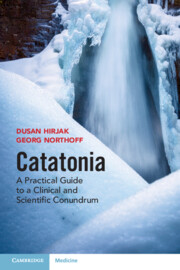Refine search
Actions for selected content:
277 results
Chapter 13 - Mood Disorders in Young People
-
-
- Book:
- Seminars in Child and Adolescent Psychiatry
- Published online:
- 10 October 2025
- Print publication:
- 30 October 2025, pp 190-218
-
- Chapter
- Export citation
Can arch anatomy predict the outcome of repaired aortic coarctation? A novel radiological parameter
-
- Journal:
- Cardiology in the Young , First View
- Published online by Cambridge University Press:
- 17 October 2025, pp. 1-8
-
- Article
- Export citation
When research data meet reality: contrasting advanced laryngeal cancer outcomes in The Cancer Imaging Archive (TCIA) and a United Kingdom regional cohort
-
- Journal:
- The Journal of Laryngology & Otology , First View
- Published online by Cambridge University Press:
- 06 October 2025, pp. 1-6
-
- Article
-
- You have access
- Open access
- HTML
- Export citation
Revived role of reverse Potts shunt in management of paediatric severe pulmonary hypertension
-
- Journal:
- Cardiology in the Young / Volume 35 / Issue 8 / August 2025
- Published online by Cambridge University Press:
- 27 August 2025, pp. 1567-1576
-
- Article
- Export citation
Application of slide tracheoplasty in children with congenital tracheal stenosis
-
- Journal:
- Cardiology in the Young / Volume 35 / Issue 9 / September 2025
- Published online by Cambridge University Press:
- 22 August 2025, pp. 1773-1781
-
- Article
- Export citation
8 - Outcome and Course of Catatonia
-
- Book:
- Catatonia
- Published online:
- 26 July 2025
- Print publication:
- 14 August 2025, pp 115-122
-
- Chapter
- Export citation
Retrospective analysis of 351 patients with vocal fold leukoplakia: impact of smoking, lesion size and histopathological grade on treatment outcomes
-
- Journal:
- The Journal of Laryngology & Otology , First View
- Published online by Cambridge University Press:
- 01 August 2025, pp. 1-7
-
- Article
- Export citation

Catatonia
- A Practical Guide to a Clinical and Scientific Conundrum
-
- Published online:
- 26 July 2025
- Print publication:
- 14 August 2025
Prognostic value of ventricular repolarisation parameters in children with dilated cardiomyopathy
-
- Journal:
- Cardiology in the Young / Volume 35 / Issue 8 / August 2025
- Published online by Cambridge University Press:
- 24 July 2025, pp. 1637-1643
-
- Article
- Export citation
Early Motor Glasgow Coma Scale Predicts Unfavorable Functional Outcome after Poor-Grade Subarachnoid Hemorrhage
-
- Journal:
- Canadian Journal of Neurological Sciences , First View
- Published online by Cambridge University Press:
- 24 July 2025, pp. 1-7
-
- Article
- Export citation
Prognostic analysis and nomogram prediction model construction of severe full-frequency sudden sensorineural hearing loss
-
- Journal:
- The Journal of Laryngology & Otology / Volume 139 / Issue 9 / September 2025
- Published online by Cambridge University Press:
- 08 July 2025, pp. 808-815
- Print publication:
- September 2025
-
- Article
- Export citation
Prediction of individualised 6-month mortality risk in opioid use disorder
-
- Journal:
- The British Journal of Psychiatry , FirstView
- Published online by Cambridge University Press:
- 07 July 2025, pp. 1-8
-
- Article
-
- You have access
- Open access
- HTML
- Export citation
Chapter 15 - Rehabilitation of Mechanically Ventilated Neurological Patients
-
-
- Book:
- Clinical Neurorespiratory Medicine
- Published online:
- 26 May 2025
- Print publication:
- 19 June 2025, pp 168-175
-
- Chapter
- Export citation
Accurate prognostic awareness is associated with increased emotional distress in Latino patients with advanced cancer
-
- Journal:
- Palliative & Supportive Care / Volume 23 / 2025
- Published online by Cambridge University Press:
- 22 April 2025, e97
-
- Article
-
- You have access
- Open access
- HTML
- Export citation
Association of Fusobacterium nucleatum with colorectal cancer molecular subtypes and its outcome: a systematic review
-
- Journal:
- Gut Microbiome / Volume 6 / 2025
- Published online by Cambridge University Press:
- 08 April 2025, e5
-
- Article
-
- You have access
- Open access
- HTML
- Export citation
Service delay in schizophrenia: case–control study of pathways to care among homeless and non-homeless patients
-
- Journal:
- BJPsych Open / Volume 11 / Issue 2 / March 2025
- Published online by Cambridge University Press:
- 25 March 2025, e65
-
- Article
-
- You have access
- Open access
- HTML
- Export citation
Chapter 11 - Measurable Residual Disease in Acute Myeloid Leukaemia
-
-
- Book:
- Multiparameter Flow Cytometry in the Diagnosis of Hematologic Malignancies
- Published online:
- 30 January 2025
- Print publication:
- 20 February 2025, pp 174-192
-
- Chapter
- Export citation
Prognostic value of the Global Leadership Initiative on Malnutrition criteria including systemic inflammation in patients with advanced cancer
-
- Journal:
- British Journal of Nutrition / Volume 133 / Issue 2 / 28 January 2025
- Published online by Cambridge University Press:
- 08 January 2025, pp. 246-252
- Print publication:
- 28 January 2025
-
- Article
- Export citation
The Roles of Understanding and Belief in Prognostic Awareness
-
- Journal:
- Cambridge Quarterly of Healthcare Ethics , First View
- Published online by Cambridge University Press:
- 22 November 2024, pp. 1-9
-
- Article
-
- You have access
- Open access
- HTML
- Export citation
Prevalence and prognosis of tinnitus in post-COVID-19 patients: a cross-sectional survey
-
- Journal:
- Epidemiology & Infection / Volume 152 / 2024
- Published online by Cambridge University Press:
- 08 November 2024, e137
-
- Article
-
- You have access
- Open access
- HTML
- Export citation
